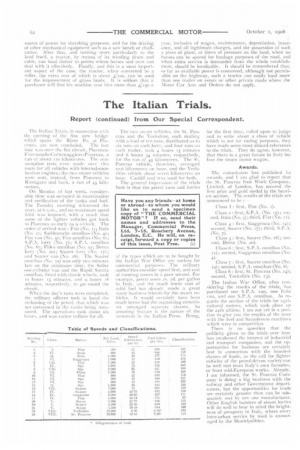The Italian Trials.
Page 2

If you've noticed an error in this article please click here to report it so we can fix it.
Report (continued) from Our Special Correspondent.
The Italian Trials, in connection with the opening of the fine new bridge which spans the River Po, at Pia
cenza, are now concluded. The last tour was over the flat circuit, PiacenzaFiorenzuela-Cortema.ggiore-Piacenza, run of about 120 kilometres. The conswap non tests were made over this route for all vehicles with internal-combustion engines; the two steam vehicles were sent, instead, from Piacenza to Riverg,aro and back, a run of 45 kilometres.
On Monday of last week, considerable time was occupied in examination and verification of the tanks and fuel. The Tuesday morning witnessed the start, at 6 a.m., and no maximum speed limit was imposed, with a result thin some of the lighter vehicles got back to Piacenza as early as 9 o'clock. The order of arrival was : Fiat (No. 1); Itala (No. 21; SUCklellISCht? omnibus (No. 41; Fiat van (No. 5); Fiat. omnibus (No. e); S.P.A. lorry (No, 7); S.P.A. omnibus (No. 8); Fides omnibus (No. el; Berna lorry (No. 2o); Saurer lorry (No. I7); and Snorer van (No. 0-). The Saurer omnibus (No. 19) was only two minutes late on the minimum Lime, the Soller one-cylinder van and the Rapid Savoia omnibus, fitted with elastic wheels, took rt hours 15 minutes, and 9 hours ;8 minutes, respectively, to go round the rircuit.
When the day's runs were completed, the military aleers took in hand the reckoning of the petrol, that which was not consumed in the tanks being measured. The operations took about six hours, and was rather tedious for all. The two sivarn vehicles, the St. Pancras and the Yorkshire, each dealing eith a load of ten tons, distributed as to six tons on each lorry, and four tons on each trailer, took 4 hours 15 minutes and 6 hours 34 minutes, respectively, for the run of 45 kilometres. The St. Pancras vehicle, therefore, averaged io.6 kilometres in hour, and the Yorkshire vehicle LhuLIt seven kilometres an hour. Cardiff coal was used for both.
The general impression of the trials here is that the petrol vans and lorries
of the types which are to be bought by the Italian War Office are useless for commercial purposes The military authorities consider speed first, and cost of running conies in a poor second. For example, petrol costs 2.`,;. sd. per gallon in Italy, and the much lower cost of solid fuel has already made a great many business friends for the steam vehicles. It would certainly have been much better had the organising committee arranged separate classes. An amusing feature is the nature of the comment in the Italian Press. Being,
for the first time, called upon to judge and to write about a class of vehicle which is not for racing purposes, they have made some most absurd references to the trials. They do agree, however, that there is a great future in Italy before the steam motor wagon.
Awards.
The commission has published its awards, and I am glad to report that the Sr. Pancras Iron Work Company, Limited, of London, has secured the first prize and gold medal in the heaviest section. The results of the trials are announced to be :- Class I: first, Fiat (No. t).
Class a: first, S.P.A. (No. 15); second, Itala (No. 3); third, Fiat (No. 1), Class 4 : first, Gaggenau (No. 141; second, Saurer (No. 17); third, S.P.A. (No. 7).
Class 5 : first, Saurer (No. IS); second, Berna (No. so).
Class 6 : first, S.P.A. omnibus (No. 12); second, Gaggenau omnibus (No.
4) Class 7 : first, Saurer omnibus (No. It)); second, S.P.A. omnibus (No. 8).
Class 8 first, St. Pancras (No. 24); second, Yorkshire (No. 23).
The Italian War Office, after considering the results of the trials, has, purchased one S.P.A. van, one Rata van, and one SPA. omnibus. As regards the section of the trials for agricultural motors, which took place on the 24th ultimo, I am not vet in a position to give you the results of the tests with the lveland Saunderson machines which were in competition.
There is no question that the publicity given to the trials over here has awakened the interest of induetrial and transport companies, and the Opportunities for business are certainly best in connection with the heaviest classes of loads, as the call for lighter vehicles of the petrol-driven variety can be well met from Italy's own factories, or from mid-European works. Already, I am informed, the St. Pancras Company is doing a big business with the railway and other Government departments, but the opportunities for trade are certainly greater than can be adeuuately met by any one manufacturer. Other English builders of steam lorries will do well to bear in mind the brightness of prospects in Italy, where every inter-urban service by road is encour aged hv the Municipalities. ,




















